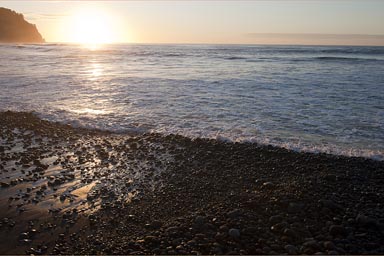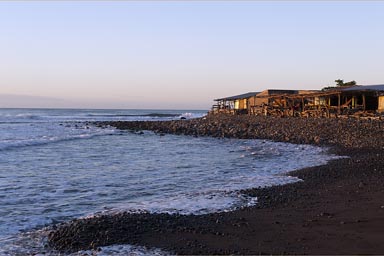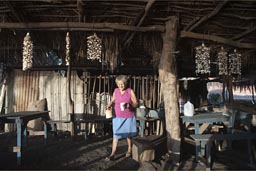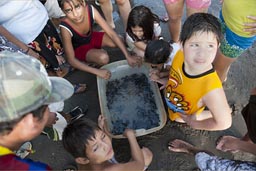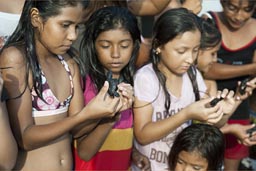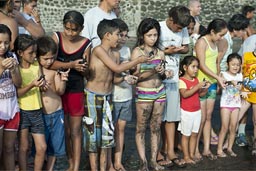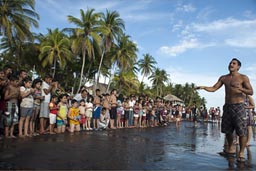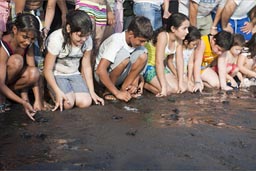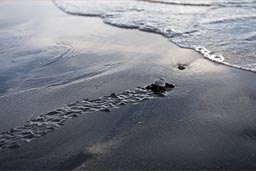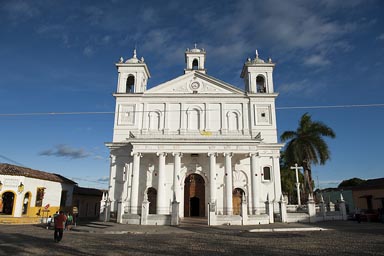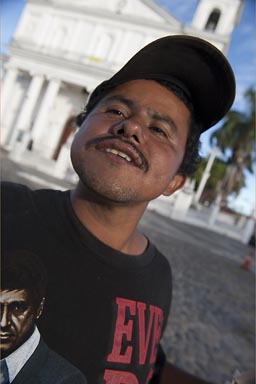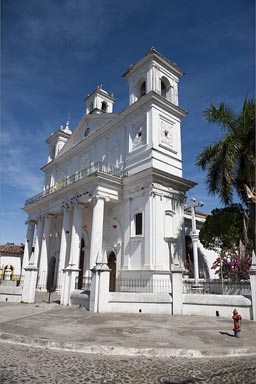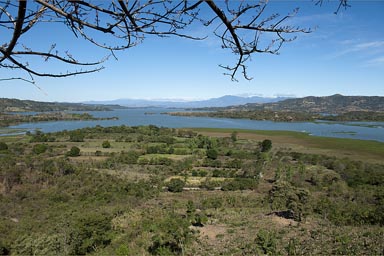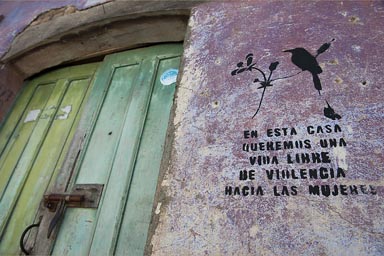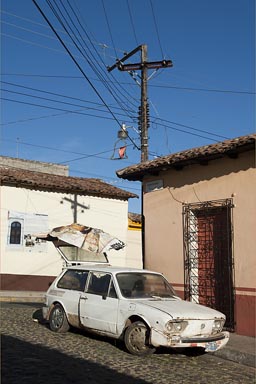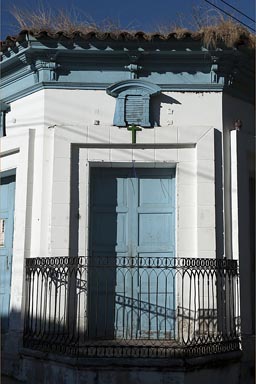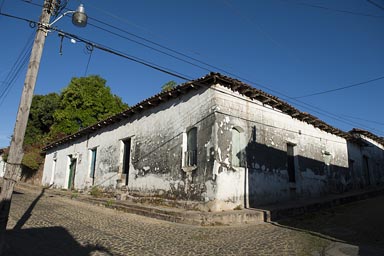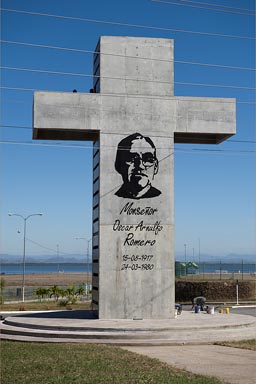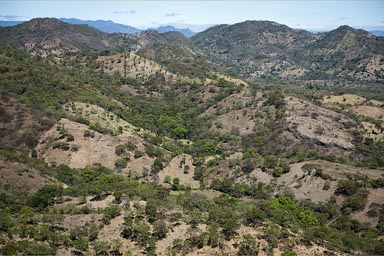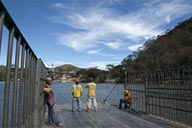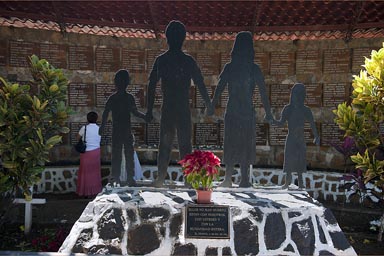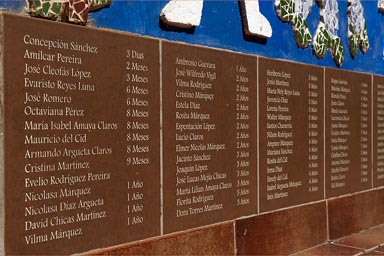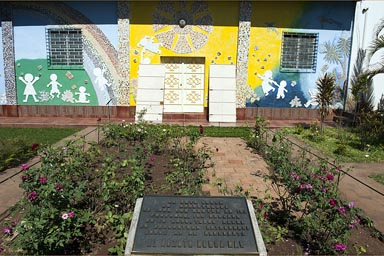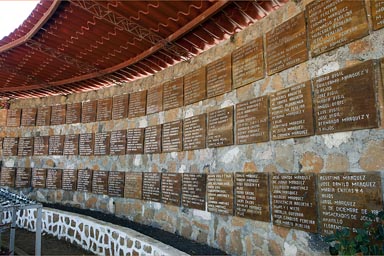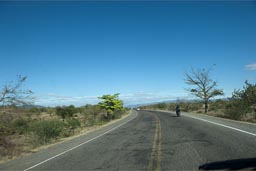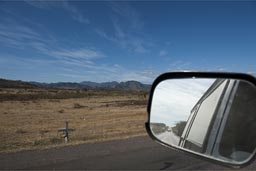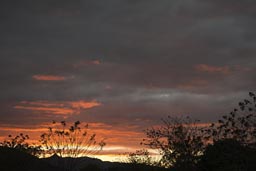www.thisfabtrek.com > journey > central-america-caribbean > el-salvador > 20120105-el-mozote
For New Year's Eve and after, El Zonte receives us nicely.
Download GPS (KML) track/waypoints.
Wanderer - put it in perspective, when you go through the notes already 3 months and 5000kms later in Colombia; this Central America is a faint memory of a passage in time almost unreal, to be believed it happened. This is why the writing is good, the recollecting of events, so we don't forget. "Live and remember so we can write" as Gabriele Garcia Marquez is always quoted.
El Salvador receives Christina and me nicely; stopping at a drinking and eating joint in a bend before a tunnel on the coastal highway with a great view on the Pacific Ocean we run into two guys and their families, one is Roberto Salamanca Silva, Salvadorian pop star, guitar player and producer, the other a Salvadorian, named Mohamed, but he has not set foot onto his fathers land, Lebanon, ever, "try and become American first", his father told him "this is difficult enough with my name" he smiles. Both men recommend to go to El Zonte and we do and in hindsight those days seem like a grace period, in the hammock in sheds that are patched up of drift wood atop the black volcanic boulders and pebbles of El Zonte's headland and beach.
On 31st of Dec we are completely alone, watch the pre-midnight fireworks explode on the other side of the bay while our guy in the bar who never lets a smile fly blasts out music for himself and dishes us the greatest of Columbian Salsa; with the crashing waves of the Pacific a few meters away it blends into a soothing cocktail. I think about my boys, and here is a time for celebration, a bluesy moment, a Churchill sized Cuban Romeo and Julieta, yes, 2012 was a good year, a busy year and I managed to spend more time than ever with Daniel and David; the boys what are they up to right now?
After midnight and some 20 Golden, the El Salvadoran light brew in small bottles, we join the other crowd, the surf and hippie folk, but they would not talk to us and we not to them and I get the old Mescal bottle from Mexico out to make a deep dent.
Release of baby turtles, a race to freedom...
On 1st of Jan the world here has changed, the place overflows with families from San Salvador, I sleep it out in a hammock in one of the sheds. A swim late in the afternoon is balsam, the waves wash the dirt away.
On the beach a crowd gathers around a little water basin, mostly children and their excitement is great. In the famous turtle race to the ocean, small hatched turtles, and the oldest just 14 days old, are about to be released to freedom, the un-know, a dangerous world for tiny turtles. Many won't survive, but it is nature's way of working, the only way, and with luck some come back and lay their eggs in the years that come, right here in El Zonte.
The kids line up behind a mark in the sand, the main hatchery guy explains, talks to the deaf and numb not to leave trash on the beach. Then the kids with a kiss and a prayer send their turtles on the journey, one by one they crawl over the sand, being flushed backwards by the first waves then manage to ride out and paddle into sunset on the huge pacific Ocean.
When night after the 1st comes over El Zonte and all have left again, the beach looks devastated, plastic bottles, chips packets, glass, paper cups, not one has taken his trash with him!
San Salvador, can you feel the heat?
The second of Jan comes and we leave, search for another beach, but in the middle of what is the silly season all is full, loud and my brain still sensitive from New Years eve. Also some is not safe at all here, when we reach La Libertad I feel the heat in my neck, "let's get out of here!" it feels God damn dangerous. Later on 5th of Jan I would get my hands on the latest homicides statistics in La Prensa Gráfica, confirmation for my awkward feelings as the departamento de La Libertad ranks only second to San Salvador. And this second of January it is San Salvador where we're headed for, the bus drivers are on strike for killings targeted at them for extortions, and when evening comes and we curve around for a place to park and sleep I feel the devil again sitting in my neck, his weight bears heavy on my shoulders. In such situations the seasoned traveller has learned the importance of relying and following his instincts; I watch my mirrors, am ready to accelerate, I let space in front so I could if needed. We spend night on a McDonald's compound, there are two armed guards, they lock the gates at midnight. Yes, a lot of shootings happen left and right from here outside the nightclubs, they confirm; so it is not just the poorer quarters that are effected by gang violence.
Suchitoto
The morning after the night, the guards wake us before they go home and we escape San Salvador north for Suchitoto, a peaceful touristy village, it has a white church, a plaza, narrow cobble stone streets around, a large windy lake nested in rolling hills. In the cafe on the main square I find time to read up on revolutionary and martyr Farabundo Martí (wiki), killed 1932 in La Matanza (Massacre, Slaughter), a military campaign that killed 30,000 peasants and indigenas. Almost all of the 20th c. El Salvador was ruled by dictators and repressive police and military, some did not shy away from even killing priests while holding mass in churches (Archbishop Oscar Romero (wiki) was just one of many). Farabundo Martí's legacy lives on in the Frente Farabundo Martí para la Liberación Nacional, FMLN, the guerilla freedom fighters, the party that basically won the 12 year long civil war against the incompetent US backed juntas, a war that cost 75,000 lives (Civil War, wiki). The end of the cold war and a changed US set of minds made the peace accords of Chapultepec in 1992 possible and the FMLN transformed itself in a center left party which managed to win the recent (2009) presidential elections in the country.
Northern El Salvador.
Setting out the next day, we venture on an uncertain (potentially unsafe) trip along El Salvador's North, going east mostly on dirt roads and we have to ask ourselves through from village to village. Mid day we embark on a caged ferry over the Río Lempa river, a huge highway bridge is in the making overhead. On the other side we take two nasty passengers, one a Pentecostal pastor who tries to deceive us about the road immediately, he also left his wife and lives with his girlfriend, this lying jerk thinks this is all fine, we get rid of them when he diverts us to Barrio, another not so safe town. Barrio is known for its prison and its 1,500 inmates, some are said to conduct their businesses from behind bars, thus Barrio attracts all kind of gang works, and the young, committed and drugged-out are the worst.
After finding our way we hop along the dirt tracks, but road building efforts that are enormous out here make for frequent halts. "Busses are being highjacked and bus-drivers killed for a 30USD rent (extortion)". That we learn while we wait again where the traffic is stopped, and we only made it 30 minutes away from Barrio. "Today we have 2 military on the bus", explains us the driver, and that "just last week bullets had shattered my windshield, one passed close by my head, luckily people only got hurt by flying glass". No, we don't feel great when the waiting takes even longer, soon night will fall, I think, we'd be such an easy target, and who knows who is who, which car or motorcycle carries people with guns out here in the jungle between the villages. Yes, "it's gotten worse since the civil war", moans the driver, "at least then we knew who was who and what were their causes!" After seemingly endless bends around hills we reach dark and unlit Osicala, and make it north and up the cold mountain at night to Perquín on a good road. Perquín is safe, not so El Mozote, said the bus driver.
Perquín, guerilla capital.
Perquín is the old guerrilla 'capital', the next morning while we eat some Popusas (fluffy tortillas) with beans and cheese inside, and we never had them better and fresher than in Perquin, the La Prensa headline reads: Two soldiers arrested for bus robbery! Who knows who is who?
In Perquín there is a Museum of the Revolution, ex-fighter Carlos tells us the story, how the civil war started when in 79/80 the US supported generals and their death squads started killing just about everybody, even 'moderates' equals 'center-rights', students, priests, journalists, entire villages, civilians, babies, women and old (1980 12,000, 1981 16,000, 1982 8,000, 1983 8,000, to do this these guys received $1.5 million a day from the US. wiki). There is the wreck of a brought down US helicopter, a huge bomb crater, a model of a guerilla camp, the radio station equipment that broadcasted during the civil war, lot's of photos of dead fighters and billboards, some in German, most bear the lone red (Soviet) star. It makes us cry, something is stuck in my throat, I wonder why didn't I then understand, when I was in university? Those same German billboards had hung on our campus walls, explaining US involvement, financing and training of those who carried out politically-motivated assassinations (such as the killing of Archbishop Romero). But then every El Salvador and Nicaragua support initiative came from the Group of Revolutionary Marxists and we mostly followed the US-propaganda, it was so easy to fool us then when Europe close to the iron curtain, and Vienna being damn close, had a pretty good conception of what living under the communist red star was. In Vienna we knew the poverty struck, repressed people next door. There was no freedom in Hungary, Poland or Romania.
El Mozote massacre, December 1981.
"That in the United States it came to be known, that it was exposed to the light and then allowed to fall back into the dark, makes the story of El Mozote—how it came to happen and how it came to be denied—a central parable of the Cold War." The Massacre at El Mozote (1994, Mark Danner).
El Mozote is not far, El Mozote is the sight of the massacre on 1,000 civilians, maybe many more, killed in December 1981, by special purpose unites of the Salvadorian military; the US under Reagan denied for over 10 years that it happened (wiki).
A young woman, from the next generation with ties to the victims, leads us around and sheds light on the horrors: "We have 1,200 confirmed dead, 500 of which children, we found the bones of 169 children, the 10 to 15 year olds were taken away for rape for several days, still when we construct new houses we find new bones. There was only one survivor, Rufina Amaya, who hid in a tree and told the story, when ever she came back she would loose her voice, she died in 2007 and is buried here along with her lot. Children were killed with knifes, babies thrown in the air and stabbed with machetes. On the walls the killers wrote: Por la patria y con Dios, for the nation and with God. The men and women were cremated, houses set on fire, everything was destroyed. After the massacre, those who came back from where they had been, left the area. Only on insisting after the end of the civil war, excavations started in the completely overgrown bush. The archeologists and experts went in and cleared out the bush, this is how the new El Mozote started".
Living atop dead bodies, I shudder, this is such a sad place, denouncing the massacre should be a crime. Now the president, Mauricio Funes comes, he is the first to acknowledge government involvement, the first to apologize on their behalf. "What shall we ask him? Ask for reparations?" our women poses the question. Will anyone ever get indited, go to jail for the crimes committed? So-far amnesty laws protect those involved. But international courts could pick up the case, maybe not this year, maybe in 5 or 10 years. Por la patria y con Dios... Our woman puts it simple "By God they will find justice, one day and as sure as death."
Driving away, we take a female passenger, a resident from the new El Mozote, and she puts us back to todays reality: "Today is the 5th, the night before the 6th, that night we used to go out. But no-one goes out anymore at night, people are dead scared again. You think El Mozote is far and no-one would bother us, but they come here and do whatever they want. El Mozote is dangerous!" We leave her in the village down the road. We drive in silence, we pass dangerous San Francisco, dangerous San Miguel, get to dangerous Tamarindo beach, no hotel, no restaurant is working out, everything has shut shop.
The Bay View Hotel then surprises, we oversaw it on the way in, on its terrace one has the most amazing view over a white beach, but also bad food and American 70s bad-ass rock music from Radio Exodus, almost unbearable but they love it. We are almost alone and meet the owner Roger whose grandfather bought it in 67, they left it untouched for some decades; these are the beaches where the arms for the guerillas came through from Nicaragua, these terrains where hotly fought over.
So why after all is El Salvador such a violent and frightening place on one side, a beautiful country of friendly people with amazing economic growth for more than a decade on the other side? Drugs and gang violence is the short answer! The US keeps/consumes the drugs but repatriates Latino criminals involved, and many are sons of civil war refugees, were left in US cities with no parental guidance when parents returned. There they start doing drugs and guns, eventually get caught and sent 'home'. It seems nothing that comes from the US has ever been good, first the bombs and the copters, the death squads, the guns and the killers, now just the guns and the killers.
Honduras.
There is chaos at the border, government officials and street businesses are hard to distinguish, a friendly joking woman in an office is dedicated to ease a tourist's border crossing formalities. But still they ask for more copies then ever, somewhere I stand in line to pay some fees when a mulatto lady presses her tits in my back, so close does not come by chance, I am about to be robbed and hold my bag tightly.
We enter Honduras and this is the Pan-Americana highway which I usually try hard to avoid. Honduras has an even worse reputation than El Salvador, our time doesn't permit a stay, we intend to just drive through. The devil is sitting in my neck, I drive with no ease at all, my instincts put me on high alert, I watch my mirrors, each motor cycle, each truck, this is such a tense experience and maybe a bit unjustified. But we do not even get the chance for a single beer. Somewhere we go left, go up the mountains, there is the border again. So many more copies of all our documents; we only spent 5 hours in the country I wonder for how long and on whose shelves will they keep our 50 or so idiotic copies? We have a smallish argument with some hustler who hangs around the van while we do copies and stuff, then we enter Nicaragua where the world is a different one, the stress falls off, there is hugging and joking, so suddenly, and I know I can feel it, this is relief for mind and body, and I am usually not freaky but I am so damn happy to be here....
www.thisfabtrek.com > journey > central-america-caribbean > el-salvador > 20120105-el-mozote

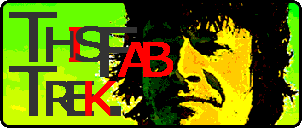
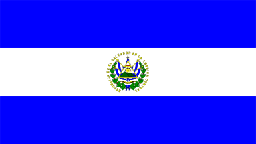
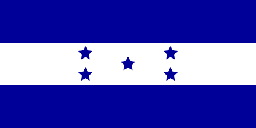
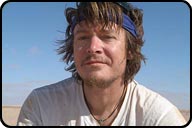
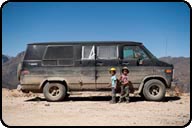


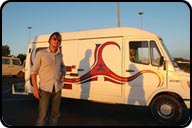
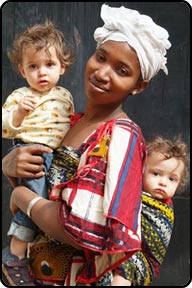
 contains Festival/Fiesta/Art photography.
contains Festival/Fiesta/Art photography.
